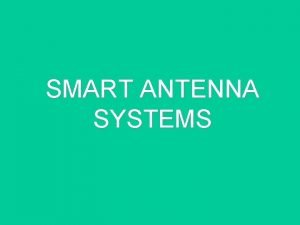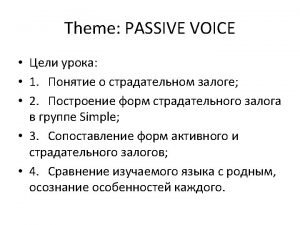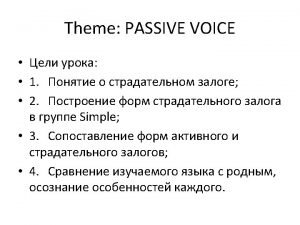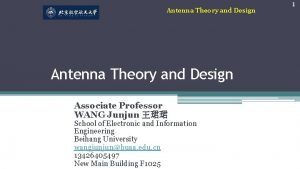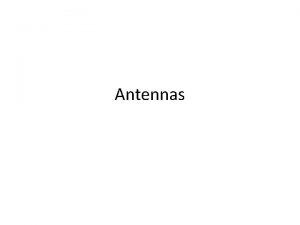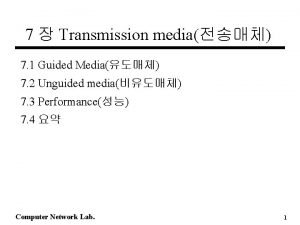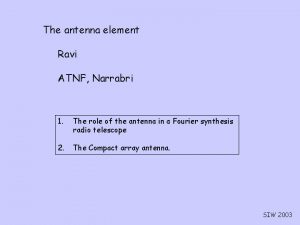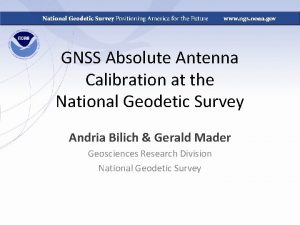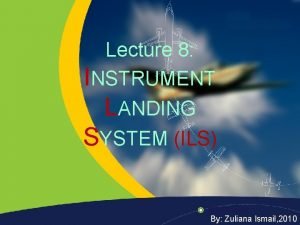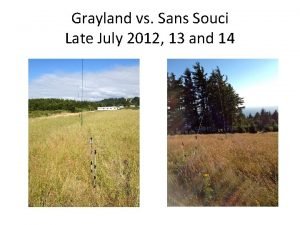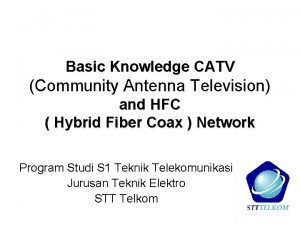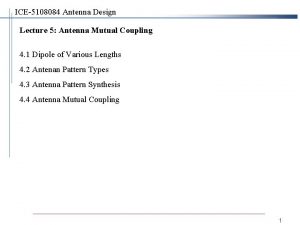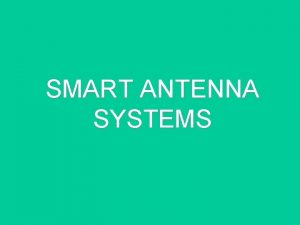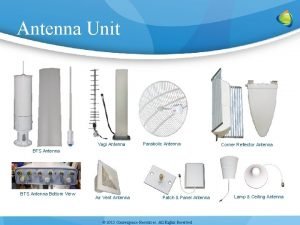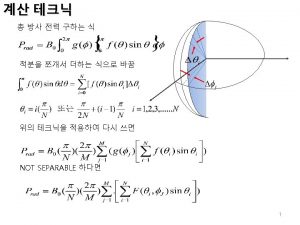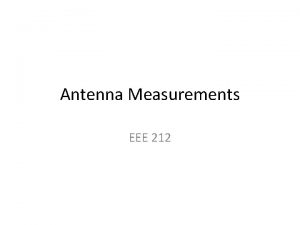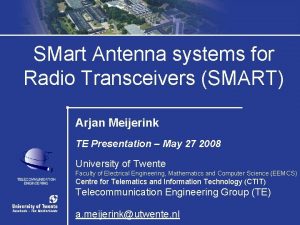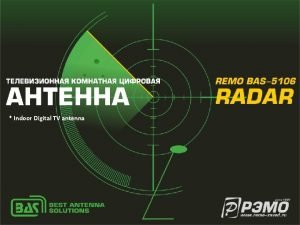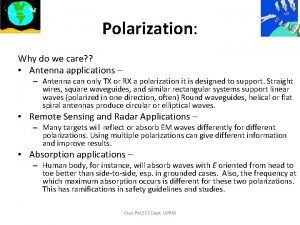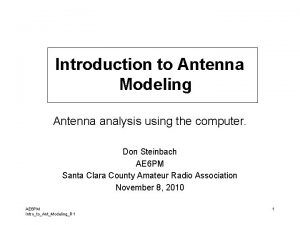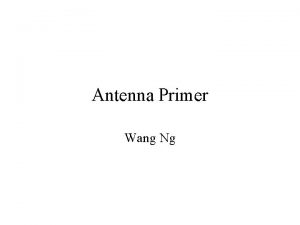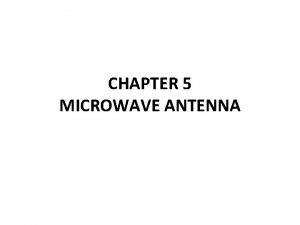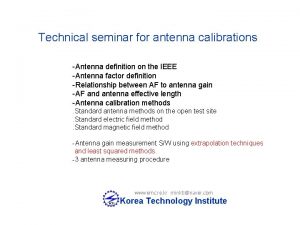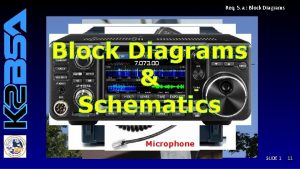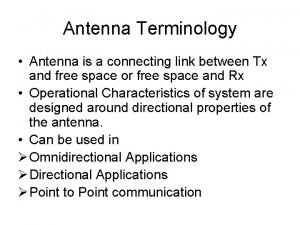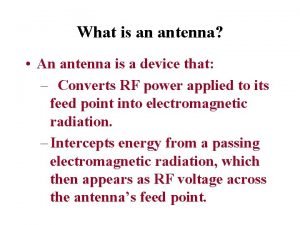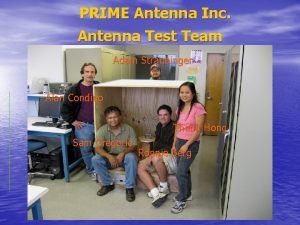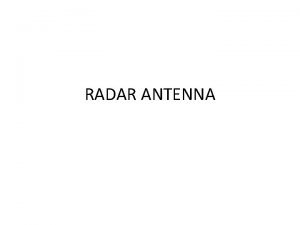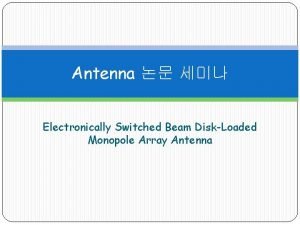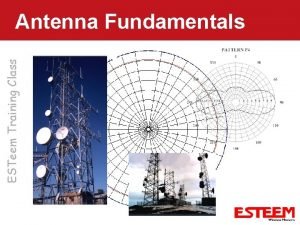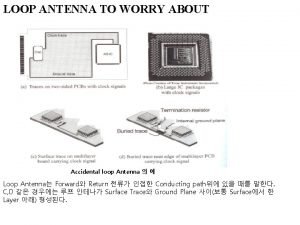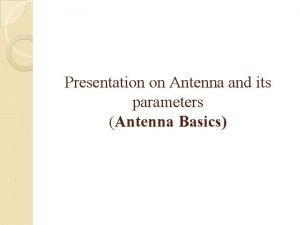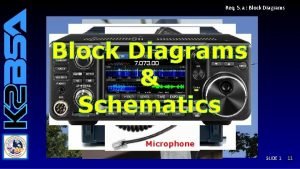What is smart antenna Smart antenna are antenna


























- Slides: 26

What is smart antenna? Smart antenna are antenna arrays with smart signal processing algorithms used to identify the direction of arrival of signal and to calculate beam forming vectors to track and locate the antenna beam on the target. There are very few techniques proposed today, which are able to improve radio network performance dramatically - Spatial processing - Multi-user detection - Channel reuse based on polarization - Advanced network control Spatial processing is among them and can be effectively combined with others techniques….

• To maximize the antenna gain in the desired direction • To minimize the gain in directions of interferers • To Reduce path losses • Overall performances of network

WHY SMART ANTENNA ARRAYS. . ? § Higher Capacity § Higher Coverage § Higher bit rate § Improved link quality § Spectral efficiency § Mobility

Smart Antenna Technology: Benfactors Operator Network capacity, coverage, less internetwork interference, filling “dead spots”, fewer BSs, Qo. S, new services. . . OEM New market for more advanced BSs, flexible radio network control. . . User Higher Qo. S, more reliable, secure communication, new services, longer battery life. . .

Smart Antenna Technology: Motivation Link level improvements System improvements - Interference cancellation at the up and down links capacity - SNR improvement due to antenna gain coverage - Multipath fading mitigation Quality of service (Qo. S), bit rate, mobility rate

Smart Antenna Propagation 1) Phased arrey system 2) adaptive array system • Use a number of fixed beams • Be able to change its antenna pattern • Select one of several beams to enhance receive signals dynamically

Broadcast channels control with SA

Different propagation environment WLL LOSS MSC Urban area BS BS No. LOSS Less density area BS MSC

Working principle Work With multiple antennas at both ends of a radio link. . Channel capacity grows linearly with number of antennas by sending different messages on each antenna with same carrier frequency 8 antennas yield 8 times the capacity If send same message on each antenna Then we get only the power gain of the antenna array, and Capacity grows only logarithmically with the number of antennas 8 antennas yield 3 times the capacity

SA Integration into Cellular Networks Network Planning - Capacity, coverage, interference planning - Joint fixed and radio network optimization, planning - System upgrade, economical issues Radio Network Management Radio Interface Receiver structure, Tx, Rx algorithms Services -> MS location Network control Smart Ant. Tech. - Spatial proc. - Resource management - call control Cell control - admission control - broadcast channel control - handover control - macro-diversity control 2 G Link level control 2. 5 G - Power Control - Quality Control - Tracking 1 G- analog systems 2 G- digital systems 2. 5 G- digital+packet +. . (GPRS, . . ) 3 G - W-CDMA 4 G- cellular+ gigabit WLAN 1 G 3 G 4 G - Time domain proc. - Coding - Detection - Diversity - ………. . Air Interface - Multiple access - Duplexing - Modulation - Framing - Availability of pilots DSP tech. SW Radio

Array. Comm (USA) - installations in WLL - tests for GSM 1800 Smart Antennas in Mobile Communications on the Globe Gigabit. Wireless(USA) WLL Ericsson (SW) first system solution with SA GSM (commercially available) Radio Design AB (SW) NMT-450 NTT Do. Co. Mo (Japan) Testbed for UTRA “ Intelli. Wave” Wireless Local Loop System Raytheon (USA) Commercially available Adaptive Smart Antenna System ARPA (USA )/Glo. Mo project Metawave (USA) Commercially available Intelli. Cell Switched Beam System UMTS … TSUNAMI-SUNBEAMSATURN/METRA Projects (EU)

Conventional Antennas & Arrays Top View Antenna Array Antenna Omnidirectional Sectorized


Spatial Processing Approaches - Sectorization - Macro-diversity with: * Combining (MRC, IRC) * Prefiltering/Coding Sectorization Macro-diversity (Trx. Coding, V-BLAST, . . . ) - Beamforming (BF) Switched-beam Smart Antenna Adaptive beamforming Switched-beam ant. Adaptive BF

Improved Parameters SNR CCI Diversity ISI Beamforming = BS MS Time domain diversity


Interference Rejection Comparison Desired Signals Co-channel Interfering Signals

Spatial Filtering for Interference Reduction (SFIR)

A simple example Design a beamformer with unit response at 600 and nulls at 00, -300, -750

SDMA • Spatial Division Multiple Access Uses an array of antennas to provide control of space by providing virtual channels in an angle domain

SDMA (Space Division Multiple Access)

USAGE OF SMART Antenna Applications to: • Cellular and wireless networks • Radar • Electronic warfare (EWF) as a countermeasure to electronic jamming • Satellite systems

Advantage of Smart Antenna - Improvement in SNR due to beamforming/combining array gain. (Improved coverage. ) - Reduced ISI. - Enhanced spatial diversity. Path diversity. - Interference cancellation. In Trx. and Rx. Capacity. - Improved transmission rate with link adaptation techniques. - Low wastage of power

Drawbacks of Smart antenna Smart Antennas might be not very smart (Complexity) Integrated but relatively simple system design can provide considerable improvement with low level of complexity Cost is one of the major factor in Smart Antenna approach

Hasan Mohammad Mehdi • 060909 Md. Ikram Hossain • 060918 Md. Monzur Rahman • 050931

 Antigentest åre
Antigentest åre Smart antenna
Smart antenna It's not how smart you are it's how you are smart meaning
It's not how smart you are it's how you are smart meaning Street smart vs book smart quotes
Street smart vs book smart quotes Future smart smart shopping answers
Future smart smart shopping answers One smart man he felt smart
One smart man he felt smart Book smarts vs street smarts
Book smarts vs street smarts It's not how smart you are it's how you are smart
It's not how smart you are it's how you are smart Smart two men are
Smart two men are Street smart vs book smart quotes
Street smart vs book smart quotes Current and voltage distribution in antenna
Current and voltage distribution in antenna Design and fabrication 1202
Design and fabrication 1202 Balun is a device
Balun is a device Antenna looks like a gigantic scoop
Antenna looks like a gigantic scoop Rig expert aa-30
Rig expert aa-30 Automatic direction finder block diagram
Automatic direction finder block diagram Microwave antenna
Microwave antenna Digital antenna newton
Digital antenna newton Ngs antenna calibration
Ngs antenna calibration Palomar engineers loop antenna
Palomar engineers loop antenna Radio frequency antenna
Radio frequency antenna Marker ils
Marker ils Dkaz antenna
Dkaz antenna Antenna calibration
Antenna calibration Eh antenna theory
Eh antenna theory Community antenna television
Community antenna television Monopule
Monopule

